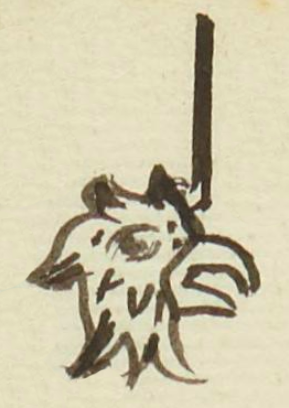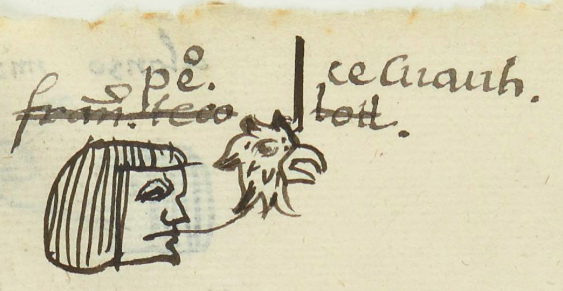Ce Cuauh (MH658v)
This black-line drawing of the simplex glyph and notation for the personal name Ce Cuauh (“One Eagle,” or “1-Eagle,” attested here as a man’s name) shows the head of an eagle (cuauhtli) in profile, facing toward the viewer’s right. Its feathers are mottled and spiky along the top of the head. Its eye and beak are open. The vertical black line to the right of the eagle’s head is meant to provide a visual for the number one (ce), a companion number for the day sign (cuauhtli) in the tonalpohualli, 260-day religious divinatory calendar.
Stephanie Wood
By 1560, when this manuscript was made, calendrical names were sometimes losing their numbers. And sometimes only the number survived (such as in the names Macuil or Matlac). This could have been owing to a suppressive force of the colonial context, where there was concern among the clergy that people were still naming their children according to the divinatory codices and preserving original Indigenous beliefs and practices. Or it could have been an effect of self-censoring, or even forgetting the old system. But this name does have the numerical component.
Stephanie Wood
1560
Jeff Haskett-Wood
águilas, números, calendarios, días, fechas, tonalpohualli, tonalamatl, nombres de hombres, feathers, plumas

ce, one, https://nahuatl.wired-humanities.org/content/ce
cuauh(tli), eagle, https://nahuatl.wired-humanities.org/content/cuauhtli
Uno Águila, or 1-Águila
Stephanie Wood
Matrícula de Huexotzinco, folio 658v, World Digital Library, https://www.loc.gov/resource/gdcwdl.wdl_15282/?sp=397&st=image
This manuscript is hosted by the Library of Congress and the World Digital Library; used here with the Creative Commons, “Attribution-NonCommercial-ShareAlike 3.0 License” (CC-BY-NC-SAq 3.0).






